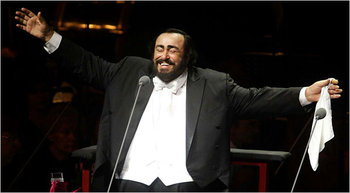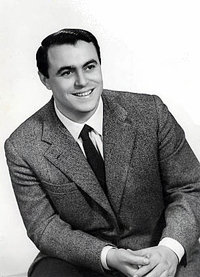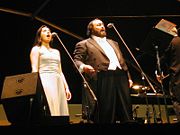Luciano Pavarotti
Luciano Pavarotti (October 12, 1935 – September 6, 2007) was a celebrated Italian tenor and one of the most popular vocal performers in the world of opera and across multiple musical genres. Known for his televised concerts, media appearances, and as one of The Three Tenors, Pavarotti was also noted for his award-winning charity work, raising money on behalf of refugees, the Red Cross and other worthy causes.
Pavarotti began his career as a tenor uneventfully. He sang opera in obscurity throughout Europe, but broke out after a performance with soprano Joan Sutherland, who invited the young tenor to join her in touring internationally. By the 1970s, Pavarotti had become known worldwide, famed for the brilliance and beauty of his tone especially into the upper register. (Warrack, John and Ewan West (1996)). "Luciano Pavarotti." The Concise Oxford Dictionary of Opera. (3rd Ed.), Oxford University. ("...a ringing, high lyric tenor of great beauty, an excellent technique, and a conquering personality.") His "high C" would become one of his trademarks.
Pavarotti also performed Nessun Dorma (see "Pavarotti Singing (Videos)" at bottom of page) for the opening ceremony of the 1990 FIFA World Cup in Italy. The first of the famed The Three Tenors concerts was held on the eve of the final match of the tournament in which Pavarotti performed together with fellow star tenors Plácido Domingo and José Carreras. Through these performances, Pavarotti brought hits previously confined to the opera world to a much wider audience; Pavarotti further spread his influence with appearances in advertisements and concerts with pop stars. Unlike many crossover artists, Pavarotti always maintained his identity as an opera star.
Early life and musical training
Luciano Pavarotti was born on the outskirts of Modena in north-central Italy, the son of Fernando Pavarotti, a baker and singer, and Adele Venturi, a cigar factory worker. Although he spoke fondly of his childhood, the family had little money; its four members were crowded into a two-room apartment. According to Pavarotti, his father had a fine tenor voice but rejected the possibility of a singing career because of nervousness. World War II forced the family out of the city in 1943. For the following year they rented a single room from a farmer in the neighboring countryside, where young Pavarotti developed an interest in farming.
Pavarotti's earliest musical influences were his father's recordings, most of them featuring the popular tenors of the day — Beniamino Gigli, Giovanni Martinelli, Tito Schipa and Enrico Caruso. At around the age of nine he began singing with his father in a small local church choir. Also in his youth he had a few voice lessons with a Professor Dondi and his wife, but he ascribed little significance to them.
After what appears to have been a normal childhood with a typical interest in sports — in Pavarotti's case football above all — he graduated from the Schola Magistrale and faced the dilemma of a career choice. He was interested in pursuing a career as a professional football goalkeeper, but his mother convinced him to train as a teacher. He subsequently taught in an elementary school for two years but finally allowed his interest in music to win out. Recognizing the risk involved, his father gave his consent only reluctantly, the agreement being that Pavarotti would have free room and board until age 30, after which time, if he had not succeeded, he would earn a living by any means that he could.
Pavarotti began the serious study of music in 1954 at the age of 19 with Arrigo Pola, a respected teacher and professional tenor in Modena who, aware of the family's indigence, offered to teach him without remuneration. Not until he began these studies was Pavarotti aware that he had perfect pitch.
In 1955 he experienced his first singing success when he was a member of the Choral Rossini, a male choir from Modena which also included his father, which won first prize at the International Eisteddfod in Llangollen, Wales; he later said that this was the most important experience of his life, which had inspired him to turn professional. At about this time Pavarotti first met Adua Veroni, an opera singer, whom he married in 1961.
When his teacher Arrigo Pola moved to Japan, Pavarotti became a student of Ettore Campogalliani who at that time was also teaching Pavarotti's childhood friend, Mirella Freni whose mother worked with Luciano's in the cigar factory. Like Pavarotti, Freni was destined to operatic greatness. (They were to share the stage many times and make memorable recordings together.)
During his years of musical study Pavarotti held part-time jobs in order to sustain himself — first as an elementary school teacher and then, when he failed at that, as an insurance salesman. The first six years of study resulted in only a few recitals, all in small towns and without pay. When a nodule developed on his vocal cords causing a "disastrous" concert in Ferrara, he decided to give up singing. Pavarotti attributed his immediate improvement to the psychological release connected with this decision. Whatever the reason, the nodule not only disappeared but, as he related in his autobiography, "Everything I had learned came together with my natural voice to make the sound I had been struggling so hard to achieve."
Career
1960s–1970s
Pavarotti began his career as a tenor in smaller regional Italian opera houses, making his debut as Rodolfo in La bohème at the Teatro Municipale in Reggio Emilia in April 1961.
Very early in his career, on February 23 1963, he debuted at the Vienna State Opera with the same role. In March and April 1963 Vienna saw Pavarotti again as Rodolfo and as Duca di Mantova in Rigoletto. The same year saw his Royal Opera House debut, where he replaced an indisposed Giuseppe di Stefano as Rodolfo.
While generally successful, Pavarotti's early roles did not immediately propel him into the stardom that he would later enjoy. An early coup involved his connection with Joan Sutherland (and her conductor husband, Richard Bonynge), who in 1963 had sought a young tenor taller than herself to take along on her touring to Australia. Joan Sutherland quoted in Paul Arendt, "It Was All About the Voice", The Guardian, (London), 7 September 2007: "The young Pavarotti was a revelation to the opera world. He made his debut in the US with us in Miami in 1965. He then came as part of our company to Australia, where he sang three times a week for 14 weeks, and we went on to make countless recordings together. At well over 6 feet tall and with his commanding physical presence, Pavarotti proved ideal.. The two sang some forty performances over two months, and Pavarotti later credited Sutherland for the breathing technique that would sustain him over his career..
Pavarotti made his American début with the Greater Miami Opera in February, 1965 singing in Donizetti's Lucia di Lammermoor opposite Joan Sutherland on the stage of the Miami-Dade County Auditorium in Miami. The tenor scheduled to perform that night was ill and had no understudy. As Sutherland was traveling with him on tour, she recommended the young Pavarotti as he was well acquainted with the role.
Shortly after, on April 28, Pavarotti made his La Scala debut in the revival of the famous Franco Zeffirelli production of La bohème, with his childhood friend Mirella Freni singing Mimi and Herbert von Karajan conducting. Karajan had requested the singer's engagement. After an extended Australian tour he returned to La Scala where he added Tebaldo from I Capuleti e i Montecchi to his repertoire on March 26, 1966, with Giacomo Aragall as Romeo. His first appearance as Tonio in Donizetti's La fille du régiment took place at the Royal Opera House, Covent Garden on June 2 of that year. It was his performances of this role that would earn him the title of "King of the High Cs".
He scored another major triumph in Rome on November 20, 1969 when he sang I Lombardi opposite Renata Scotto. This was recorded on a private label and widely distributed, as were various takes of his I Capuleti e i Montecchi, usually with Aragall. Early commercial recordings included a recital of Donizetti and Verdi arias (the aria from Don Sebastiano was particularly highly regarded), as well as a complete L'elisir d'amore with Sutherland.
His major breakthrough in the United States came on February 17, 1972, in a production of La fille du régiment at New York's Metropolitan Opera, in which he drove the crowd into a frenzy with his nine effortless high Cs in the signature aria. He achieved a record 17 curtain calls. He began to give frequent television performances, starting with in his role as Rodolfo (La bohème) in the first Live From The Met telecast in March of 1977, which attracted one of the largest audiences ever for a televised opera. He won many Grammy awards and platinum and gold discs for his performances. In addition to the previously listed titles, his La favorita with Fiorenza Cossotto and his I puritani (1975) with Sutherland stand out.
In 1976 Pavarotti debuted at the Salzburg Festival appearing in a solo recital on July 31 accompanied by pianist Leone Magiera. Pavarotti returned to the festival in 1978 with a recital and as the Italian singer in Der Rosenkavalier, in 1983 with Idomeneo, and both in 1985 and 1988 with solo recitals.
In 1977, he was profiled in a cover story in the weekly magazine, Time. That same year saw Pavarotti's return to the Vienna State Opera after an absence of 14 years. With Herbert von Karajan conducting Pavarotti sang Manrico in Il trovatore. In 1978, he appeared in a solo recital on Live from Lincoln Center.
He made his international recital début at William Jewell College in Liberty, Missouri in 1973 as part of the college’s Fine Arts Program, now known as the Harriman-Jewell Series. Perspiring due to nerves and a lingering cold, the tenor clutched a handkerchief throughout the début. The prop became a signature part of his solo performances.
1980s–1990s
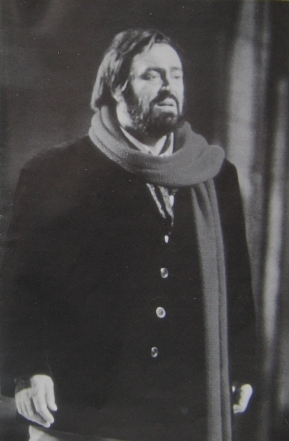
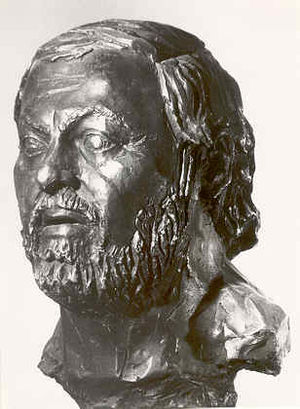
At the beginning of the 1980s, he set up The Pavarotti International Voice Competition for young singers, performing with the winners in 1982 in excerpts of La bohème and L'elisir d'amore. The second competition in 1986 staged excerpts of La bohème and Un ballo in maschera. To celebrate the 25th anniversary of his career he brought the winners of the competition to Italy for gala performances of La bohème in Modena and Genoa and then to China where they staged performances of La bohème in Beijing. To conclude the visit, Pavarotti performed the first ever concert in the Great Hall of the People before 10,000 people, receiving a standing ovation for nine effortless high Cs. The third competition in 1989 again staged performances of L'elisir d'amore and Un ballo in maschera. The winners of the fifth competition accompanied Pavarotti in performances in Philadelphia in 1997.
In the mid 1980s Pavarotti returned to two opera houses that had provided him with important breakthroughs, the Vienna State Opera and La Scala. Vienna saw Pavarotti as Rodolfo in La bohème with Carlos Kleiber conducting and again Mirella Freni as Mimi, as Nemorino in L'elisir d'amore, Radames in Aida conducted by Lorin Maazel, Rodolfo in Luisa Miller, and Gustavo in Un ballo in maschera conducted by Claudio Abbado. In 1996 Pavarotti appeared for the last time at the Staatsoper in Andrea Chenier.
In 1985 Pavarotti sang Radames at La Scala opposite Maria Chiara in a Luca Ronconi production conducted by Maazel, recorded on video. His performance of the aria "Celeste Aida" received a two-minute ovation on the opening night. He was reunited with Mirella Freni for the San Francisco Opera production of La bohème in 1988, also recorded on video. In 1992 La Scala saw Pavarotti in a new Zeffirelli production of Don Carlo conducted by Riccardo Muti. Pavarotti's performance was heavily criticized by some observers and booed by parts of the audience. The singer never returned to La Scala again.
Pavarotti became even more well-known throughout the world in 1990 when his rendition of Giacomo Puccini's aria, "Nessun Dorma" from Turandot, became the theme song of the BBC TV coverage of the 1990 FIFA World Cup in Italy. The aria achieved pop status and remained his trademark song. This was followed by the hugely successful Three Tenors concert held on the eve of the World Cup final at the ancient Baths of Caracalla in Rome with fellow tenors Plácido Domingo and José Carreras and conductor Zubin Mehta, which became the biggest selling classical record of all time. Throughout the 1990s, Pavarotti appeared in many well-attended outdoor concerts, including his televised concert in London's Hyde Park which drew a record attendance of 150,000. In June 1993, more than 500,000 listeners gathered for his performance on the Great Lawn of New York's Central Park, while millions more around the world watched on television. The following September, in the shadow of the Eiffel Tower in Paris, he sang for an estimated crowd of 300,000. Following on from the original 1990 concert, The Three Tenors concerts were held during the Football World Cups; in Los Angeles in 1994, in Paris in 1998, and in Yokohama in 2002.
Pavarotti's rise to stardom was not without occasional difficulties, however. He earned a reputation as "The King of Cancellations" by frequently backing out of performances, and his unreliable nature led to poor relationships with some opera houses. This was brought into focus in 1989 when Ardis Krainik of the Lyric Opera of Chicago severed the house's 15-year relationship with the tenor. Over an eight-year period, Pavarotti had cancelled 26 out of 41 scheduled appearances at the Lyric and the decisive move by Krainik to ban him for life was well-noted throughout the opera world, after the performer walked away from a season premiere less than two weeks before rehearsals began, saying pain from a sciatic nerve required two months of treatment.
On December 12, 1998 he became the first (and, so far, only) opera singer to perform on Saturday Night Live, singing alongside Vanessa L. Williams. He also sang with U2, in the band's 1995 song Miss Sarajevo.
In 1998, Pavarotti was presented with the Grammy Legend Award. Given only on special occasions, it has only been awarded 15 times since its first presentation in 1990 (as of 2007).
2000s
In 2002 Pavarotti split with his manager of 36 years Herbert Breslin. The breakup, which was acrimonious, was followed in 2004 with the publication of a book by Breslin entitled The King & I, seen by many as sensationalist and largely critical of the singer's acting (in opera), his ability to read music and learn parts, and of his personal conduct, although acknowledging their mutual success. In an interview in 2005 with Jeremy Paxman on the BBC, Pavarotti rejected the allegation that he could not read music, although acknowledging he sometimes had difficulty following orchestral parts.
He received Kennedy Center Honors in 2001 and holds two Guinness World Records: for receiving the most curtain calls — at 165 — and for the best selling classical album (this album is In Concert by The Three Tenors and is thus shared by fellow tenors, Plácido Domingo and José Carreras).
In 2003 he released his final compilation, Ti Adoro, which has Pavarotti singing in more of a "popera" style.
On 13 December 2003 he married his former personal assistant, Nicoletta Mantovani, with whom he already had a daughter, Alice. He started his farewell tour in 2004, at the age of 69, performing one last time in old and new locations, after over four decades on the stage. Pavarotti gave his last performance in an opera at the New York Metropolitan Opera on March 13, 2004 for which he received a 12-minute standing ovation for his role as the painter Mario Cavaradossi in Giacomo Puccini's Tosca. On December 1, 2004, he announced a 40-city farewell tour to be produced by Harvey Goldsmith.
In March 2005, Pavarotti underwent neck surgery to repair two vertebrae. In June of the same year, he had to cancel a Three Tenors concert in Mexico due to laryngitis.
In early 2006, he had back surgery and contracted an infection while in the hospital, forcing cancellation of concerts in the U.S., Canada and the UK.
On February 10, 2006, Pavarotti sang "Nessun Dorma" at the 2006 Winter Olympics Opening Ceremony in Turin, Italy at his final performence. The final act of the opening ceremony, his performance received the longest and loudest ovation of the night from the international crowd.
Pavarotti himself summarized his career as follows: "I think a life in music is a life beautifully spent and this is what I have devoted my life to." [1]
Film and television
Pavarotti's one venture into film, a romantic comedy called Yes, Giorgio (1982), was roundly panned by the critics. He can be seen to better advantage in Jean-Pierre Ponnelle's adaptation of Rigoletto for television, released that same year, or in his more than 20 live opera performances taped for television between 1978 and 1994, most of them with the Metropolitan Opera, and most available on DVD.
Death and family
While undertaking an international "farewell tour," Pavarotti was diagnosed with pancreatic cancer in July 2006. The tenor fought back against the implications of this diagnosis, undergoing major abdominal surgery and making plans for the resumption and conclusion of his singing commitments. In August 2007, however, Pavarotti was hospitalized as his condition worsened. He died September 6, 2007 at his home near Modena; his wife, sister, and three older daughters were present. In an e-mail statement, his manager, Terri Robson, wrote, "The Maestro fought a long, tough battle against the pancreatic cancer which eventually took his life. In fitting with the approach that characterized his life and work, he remained positive until finally succumbing to the last stages of his illness.
The Vienna State Opera and the Salzburg Festival Hall flew black flags in mourning. Tributes were published by many opera houses, such as London's Royal Opera House.
Pavarotti was survived by four daughters: three, Lorenza, Cristina and Giuliana with first wife Adua, to whom he was married for 34 years; and one, Alice, with second wife Nicoletta Mantovani. At the time of his death, he had one granddaughter.
Humanitarian work
Pavarotti annually hosted the "Pavarotti and Friends" charity concerts in his home town of Modena in Italy, joining with singers from all parts of the music industry to raise money for several UN causes. Concerts were held for War Child, and victims of war and civil unrest in Bosnia, Guatemala, Kosovo and Iraq. After the war in Bosnia, he financed and established the Pavarotti Music Center in the southern city of Mostar to offer Bosnia's artists the opportunity to develop their skills. For these contributions, the city of Sarajevo named him an honorary citizen in 2006.
He performed at benefit concerts to raise money for victims of tragedies such as an earthquake in December 1988 that killed 25,000 people in northern Armenia.
He was a close friend of Diana, Princess of Wales. They raised money for the elimination of land mines worldwide. He was invited to sing at her funeral service, but declined, as he felt he could not sing well "with his grief in his throat". He nonetheless attended the service.
In 1998, he was appointed the United Nation's Messenger of Peace, using his fame to raise awareness of UN issues, including the Millennium Development Goals, HIV/AIDS, child rights, urban slums and poverty.
In 2001, Pavarotti received the Nansen Medal from the UN High Commission for Refugees for his efforts raising money on behalf of refugees worldwide. Through benefit concerts and volunteer work, he has raised more than US$1.5 million, more than any other individual.
Other awards he received for charity work include the Freedom of London Award and The Red Cross Award for Services to Humanity, for his work in raising money for that organization, and the 1998 MusiCares Person Of The Year, given to humanitarian heroes by the National Academy of Recording Arts and Sciences.
See Pavarotti Singing (Videos)
- Recondita Armonia
- Nessun Dorma final act of Giacomo Puccini's opera Turandot
- Rigoletto, La Dona e mobile
- Che gelida manina (Boheme)
- Ave Maria Schubert
- "Granada" by Lara
- Celeste Aida
- "Caruso" from Caruso the Movie
- "It's A Man's World" The late James Brown & Luciano Pavarotti
- Tribute To The Late Legend Luciano Pavarotti
External links
- Official website
- Discography at Discogs.com
- Review of The King and I at Bookreporter.com
- Review of The King and I at theage.com.au
- Signature of Luciano Pavarotti
- Bernard Holland, "Luciano Pavarotti, Italian Tenor, Is Dead at 71", The New York Times, 6 September 2007, obituary
- Anthony Tommasini, "An Appraisal: A Master of Italian Operatic Artistry", The New York Times, 6 September 2007
- Pavarotti Ring Tones
